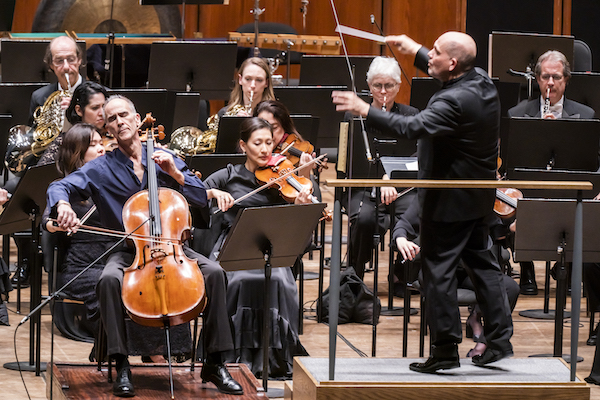A premiere, joyous Haydn and mixed Mozart from van Zweden, Philharmonic

Nearly 140 years after the United States Constitution was written, women earned the right to vote when the 19th Amendment was ratified and adopted. The New York Philharmonic is marking that centennial with Project 19, a series of new scores commissioned from 19 women composers, set to be heard through the next few seasons.
With new artwork in the David Geffen Hall lobby spaces, and representatives from the League of Women voters on hand, Project 19 took its first public step Wednesday night when the orchestra premiered Tread softly, by Nina C. Young.
It’s easy to admire the Philharmonic’s ambition and sense of purpose but despite the sense of occasion one felt that, musically the evening could have come off with more daring and imagination.
But this was only a partial attempt at doing something different, more so because the context was the century past. Wednesday’s concert program was the stale overture-concerto-symphony format—with Carter Brey playing Haydn’s C Major Cello Concerto and Mozart’s Great Mass in C minor substituting for the second half symphony. Two concert warhorses (as fine as they may be) seemed intended as reflexive balm meant to soothe the audience after a contemporary work.
As it turned out, Tread softly was an acceptable and fairly predictable commission, a work with skilled notation and a rote conception, the kind of thing that makes up the bulk of new music from professional composers.
The title comes from Yeats’ heartbreaking poem, “The Cloths of Heaven,” though the music had none of the stanzas’ self-sacrificial ardor. Young, a New Yorker, meant it as a series of personal musical reminiscences.
This followed a personal logic that was not compelling. The structure was intuitive, and Young’s transitions from one idea to the next were skillful—including an exceptionally clever quote from the Scherzo of Beethoven’s Ninth Symphony—but the destinations didn’t always resonate. This was like listening to someone’s dreams, a private and necessarily obscure experience, and the arch form—rising to a late climax and colorful, misty, denouement—was so standard that it caught the piece at a difficult halfway point between an intriguing surrealism and a conventional neo-romantic narrative. Even full of ringing, beguiling sounds, Tread softly still failed to make a strong individual impression.
In the Haydn Cello Concerto, Brey’s technique was fluid, and in longer phrases he produced a singing tone and vibrato. Nearly as striking was his stage attitude. When the orchestra played, he sat back and crossed his legs, bobbed his head, tapped his foot. He was enjoying himself thoroughly, and when he was playing he was enjoying the experience even more. A fine performance made distinctive by the clear and infectious pleasure of the Philharmonic’s principal cellist.
Even with a stellar lineup of vocal soloists, the star of the Mozart Mass was the Concert Chorale of New York, under the direction of James Bagwell. Under van Zweden, the orchestra played with professional disinterest—all the notes were there, each and every phrase played exactly the same way—yet the Chorale sang with a sense of urgency, a genuine passion for the music and the sheer act of performing.
The soloists possessed a disparate set of styles not often heard in choral music. Soprano Miah Persson offered a bright, pleasantly dry sound that hovered above the orchestra, although the rapid turns and trills of “Et incarnatus est” slowed her down. Soprano Susanna Phillips— a late fill-in for Amanda Majeski, whose Philharmonic debut was thwarted by illness—displayed her creamy, colorful tone, oil to Persson’s balsamic vinegar.
The men have little to do in the mass. Nicholas Phan showed excellent balance of gentleness and strength in “Quoniam tu solus,” and bass-baritone Andrew Foster Williams rounded out the group and chorus in the closing “Benedictus.” But other than the oboe accompaniment in the Incarnatus, the orchestra playing lacked the color and verve of the soloists and chorus.
This program will be repeated 7:30 p.m. Thursday, 8 p.m. Saturday, and 7:30 p.m. February 11. nyphil.org
Posted Feb 12, 2020 at 9:04 pm by Harry Saltzman
I came to Geffen Hall to hear a program in the ” stale overture-concerto-symphony format and only took my seat in time for the first piece because I sat in the center of the row and didn’t wish to disturb those already seated. So I sat through 10 or so minutes of 21st century twaddle.
Even though you thought that “Tread Softly” failed to make a strong individual impression, you, along with Mr. Tommasini of the NY Times, seem to feel that there is something wrong with programs made up of fusty old warhorses. I think you have it backwards. We came for the Haydn and Mozart.